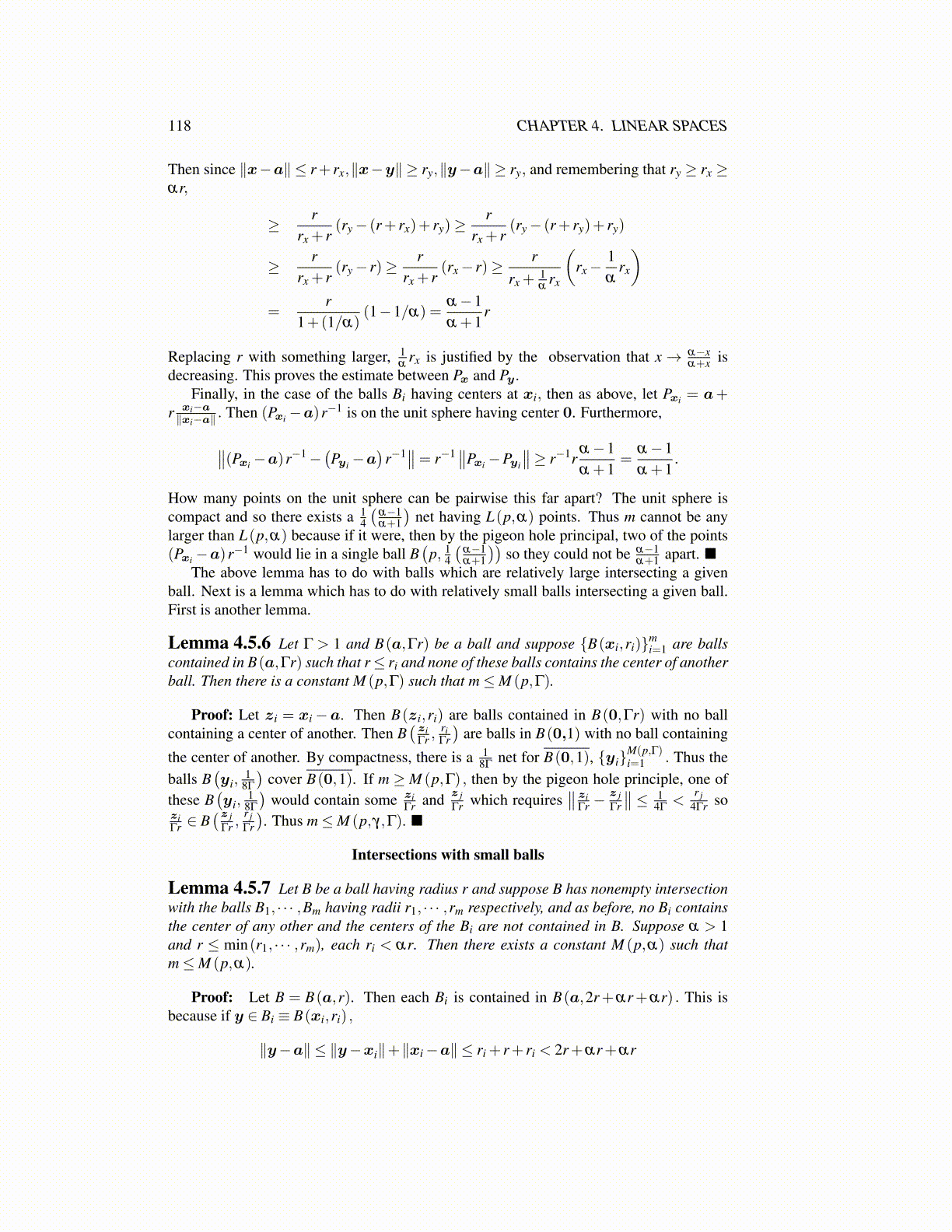
118 CHAPTER 4. LINEAR SPACES
Then since ∥x−a∥ ≤ r+ rx,∥x−y∥ ≥ ry,∥y−a∥ ≥ ry, and remembering that ry ≥ rx ≥αr,
≥ rrx + r
(ry− (r+ rx)+ ry)≥r
rx + r(ry− (r+ ry)+ ry)
≥ rrx + r
(ry− r)≥ rrx + r
(rx− r)≥ rrx +
1α
rx
(rx−
1α
rx
)=
r1+(1/α)
(1−1/α) =α−1α +1
r
Replacing r with something larger, 1α
rx is justified by the observation that x→ α−xα+x is
decreasing. This proves the estimate between Px and Py .Finally, in the case of the balls Bi having centers at xi, then as above, let Pxi = a+
r xi−a∥xi−a∥ . Then (Pxi −a)r−1 is on the unit sphere having center 0. Furthermore,
∥∥(Pxi −a)r−1−(Pyi −a
)r−1∥∥= r−1∥∥Pxi −Pyi
∥∥≥ r−1rα−1α +1
=α−1α +1
.
How many points on the unit sphere can be pairwise this far apart? The unit sphere iscompact and so there exists a 1
4
(α−1α+1
)net having L(p,α) points. Thus m cannot be any
larger than L(p,α) because if it were, then by the pigeon hole principal, two of the points(Pxi −a)r−1 would lie in a single ball B
(p, 1
4
(α−1α+1
))so they could not be α−1
α+1 apart. ■The above lemma has to do with balls which are relatively large intersecting a given
ball. Next is a lemma which has to do with relatively small balls intersecting a given ball.First is another lemma.
Lemma 4.5.6 Let Γ > 1 and B(a,Γr) be a ball and suppose {B(xi,ri)}mi=1 are balls
contained in B(a,Γr) such that r≤ ri and none of these balls contains the center of anotherball. Then there is a constant M (p,Γ) such that m≤M (p,Γ).
Proof: Let zi = xi−a. Then B(zi,ri) are balls contained in B(0,Γr) with no ballcontaining a center of another. Then B
(ziΓr ,
riΓr
)are balls in B(0,1) with no ball containing
the center of another. By compactness, there is a 18Γ
net for B(0,1), {yi}M(p,Γ)i=1 . Thus the
balls B(yi,
18Γ
)cover B(0,1). If m ≥M (p,Γ) , then by the pigeon hole principle, one of
these B(yi,
18Γ
)would contain some zi
Γr and z jΓr which requires
∥∥ ziΓr −
z jΓr
∥∥ ≤ 14Γ
<r j
4Γr soziΓr ∈ B
(z jΓr ,
r jΓr
). Thus m≤M (p,γ,Γ). ■
Intersections with small balls
Lemma 4.5.7 Let B be a ball having radius r and suppose B has nonempty intersectionwith the balls B1, · · · ,Bm having radii r1, · · · ,rm respectively, and as before, no Bi containsthe center of any other and the centers of the Bi are not contained in B. Suppose α > 1and r ≤ min(r1, · · · ,rm), each ri < αr. Then there exists a constant M (p,α) such thatm≤M (p,α).
Proof: Let B = B(a,r). Then each Bi is contained in B(a,2r+αr+αr) . This isbecause if y ∈ Bi ≡ B(xi,ri) ,
∥y−a∥ ≤ ∥y−xi∥+∥xi−a∥ ≤ ri + r+ ri < 2r+αr+αr